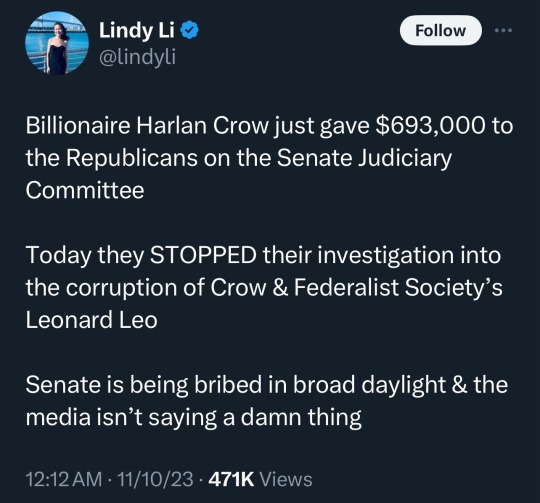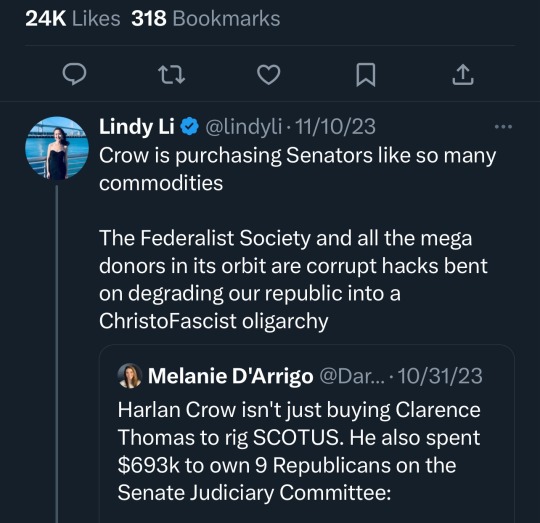#Roberts court
Text
So in the coming days you’re going to notice that a lot of white people (“allies”) who rightly post constantly and routinely about things like canceling student loan debt, abortion rights, LGBTQ issues, immigration reforms and other glaring social injustices, will suddenly have nothing to say about Affirmative Action being overturned. Not because they haven’t had time to form an opinion, but because they believe in “reverse racism” against white people, and deep down they agree with the ruling. Pay attention. Take mental notes. These people are not our allies. Believe people when they show you who they really are.
#politics#affirmative action#allies#scotus#reverse racism#fair weather ‘allies’#john roberts#roberts court#white supremacy
1K notes
·
View notes
Text

#Twitter#Alexandria ocasio cortez#Disturbing#Roberts court#Destroying#Fox news#Democrats#Supreme court#John roberts
531 notes
·
View notes
Text

This is a gift🎁link so anyone can read the entire NY Times article, even if they don' subscribe to the Times.
Jamelle Bouie does another excellent job of looking at current events through the perspective of American history. In this column, he compares the current Roberts Court with the infamous late 1850s/ early 1860s Taney Court--the Court that lost all credibility with its Dred Scott decision. Below are a few excerpts.
If the chief currency of the Supreme Court is its legitimacy as an institution, then you can say with confidence that its account is as close to empty as it has been for a very long time.
Since the court’s decision in Dobbs v. Jackson Women’s Health Organization nearly two years ago, its general approval with the public has taken a plunge.
[...]
In the latest 538 average, just over 52 percent of Americans disapproved of the Supreme Court, and around 40 percent approved.
[...]
At the risk of sounding a little dramatic, you can draw a useful comparison between the Supreme Court’s current political position and the one it held on the eve of the 1860 presidential election.
[color emphasis added]
[See more below the cut.]
NOTE: Remember that back in the 1850s/1860s the Democrats were the party that supported slavery. The Democrats and Republicans switched positions on civil rights in the late 20th century.
It was not just the ruling itself that drove the ferocious opposition to the [Taney] Supreme Court’s decision in Dred Scott v. Sandford, which overturned the Missouri Compromise and wrote Black Americans out of the national community; it was the political entanglement of the Taney court with the slaveholding interests of the antebellum Democratic Party.
[...]
Five of the justices were appointed by slave owners. At the time of the ruling, four of the justices were slave owners. And the chief justice, Roger Taney, was a strong Democratic partisan who was in close communication with James Buchanan, the incoming Democratic president, in the weeks before he issued the court’s ruling in 1857. Buchanan, in fact, had written to some of the justices urging them to issue a broad and comprehensive ruling that would settle the legal status of all Black Americans.
The Supreme Court, critics of the ruling said, was not trying to faithfully interpret the Constitution as much as it was acting on behalf of the so-called Slave Power, an alleged conspiracy of interests determined to take slavery national. The court, wrote a committee of the New York State Assembly in its report on the Dred Scott decision, was determined to “bring slavery within our borders, against our will, with all its unhallowed, demoralizing and blighted influences.”
The Supreme Court did not have the political legitimacy to issue a ruling as broad and potentially far-reaching as Dred Scott, and the result was to mobilize a large segment of the public against the court. Abraham Lincoln spoke for many in his first inaugural address when he took aim at the pretense of the Taney court to decide for the nation: “The candid citizen must confess that if the policy of the government upon vital questions, affecting the whole people, is to be irrevocably fixed by decisions of the Supreme Court, the instant they are made, in ordinary litigation between parties, in personal actions, the people will have ceased to be their own rulers.”
[color/ emphasis added]
[formatting edited]
#scotus#roberts court#dobbs v. jackson women's health organization#taney court#dred scott#legitimacy of the supreme court#jamelle bouie#the new york times#gift link
103 notes
·
View notes
Quote
Across the country, far right-wing political groups are working overtime to mobilize fear and resentment as political weapons. They are running candidates to take over local school boards. They are passing laws to whitewash our past, restrict teaching, and shut down efforts to make our schools safe and welcoming places for all students. They want to divert public education funds into private religious schools and conservative homeschoolers.
We cannot allow them to win.
Ben Jealous in NewBlackMan (in Exile). Brown v Board of Education: When the Supreme Court Rejected a Racist System by Ben Jealous
5 notes
·
View notes
Text

Corrupt SCOTUS
1 note
·
View note
Text
I'm Still Standing
What ingredients come to mind when you think of cases before the Supreme Court? One might opine controversial issues or high stakes litigation. At a case level one might say circuit splits or elite attorneys. Still, there are more elementary components of litigation mentioned in Article III and they start with a case or controversy. Central to this concept is standing – that a plaintiff suffered…

View On WordPress
#303 Creative#Acheson Hotels v. Laufer#Article III#case or controversy#Gil v. Whitford#Haaland v. Brackeen#Lujan#network analysis#Roberts Court#TransUnion LLC v. Ramirez
0 notes
Text

Roe v. Wade under siege in 2022
0 notes
Text
This didn’t hit the right audience on tiktok so I’m giving it to you guys. You guys deserve this silly little piece of GOLD I made.
#earls court#led zeppelin#robert plant#jimmy page#classic rock#dazed and confused rah 1970#70s#rock and roll#60s#jimbert#john paul jones#bonzo#rock n roll is gay#classic rock fandom#tiktok
96 notes
·
View notes
Text




The Senate Judiciary Committee on Thursday walked back a planned vote to subpoena two megadonors connected to Supreme Court Justices Clarence Thomas and Samuel Alito. The reason? Republicans threw a fit.
Democrats on the Judiciary Committee finally took the first step last week to address the high court’s ethics crisis and announced they would seek to subpoena Republican billionaire megadonor Harlan Crow and ultraconservative activist Leonard Leo. Both men feature prominently in the ethics scandal for their relationships with Thomas and Alito. The committee said it would also seek to subpoena wealthy GOP donor Robin Arkley II.
But Chair Dick Durbin appeared to put that all on hold on Thursday, when he abruptly ended a committee meeting after outraged Republicans threatened to retaliate if Crow and Leo were subpoenaed.
(continue reading)
#politics#republicans#clarence thomas#harlan crow#scotus#the federalist society#leonard leo#crony capitalism#john roberts court#roberts court#john roberts
153 notes
·
View notes
Text
If I had a nickel for every time @quiddie told a story via the medium of TTRPG that involved a PC witnessing the "monstrous" side of their love interest (also a PC) and being absolutely smitten I would have two nickels. Which isn't a lot but I'm glad it happened twice and I'm hoping it'll happen again
#i am so normal about it each time#i get invested a normal amount in Aabria's stories with themes of the monstrous and other through the lense of love#i am sane i am calm i am doing okay#aabria iyengar i am in your walls#acofaf#a court of fey and flowers#dimension 20#d20#d20 acofaf#k. p. hob#delloso de la rue#brennan lee mulligan#oscar montoya#candela obscura#candela obscura tide and bone#rajan savarimuthu#elsie roberts#noshir dalal#ashly burch#aabria iyengar#critical role#jess talks
113 notes
·
View notes
Text

332 notes
·
View notes
Text
#the raven king#all for the game#the foxhole court#aftg#tfc#the kings men#the raven cycle#the raven boys#neil josten#nathan wesninski#robert parrish#trc#trc adam#adam parrish#soc#grishaverse#six of crows#wylan van eck#jan van eck#wylan hendriks
148 notes
·
View notes
Link
484 notes
·
View notes
Text


in the court of the crimson king - king crimson
1969
ᶜᵒᵐᵖᵃᶜᵗᵐᵉᵐᵒʳʸ
#king crimson#in the court of the crimson king#art rock#prog rock#classic rock#robert fripp#70s music#60s music#physical music#cds#compactmemory
294 notes
·
View notes
Text

Supreme Court poised to appoint federal judges to run the US economy.
January 18, 2024
ROBERT B. HUBBELL
JAN 17, 2024
The Supreme Court heard oral argument on two cases that provide the Court with the opportunity to overturn the “Chevron deference doctrine.” Based on comments from the Justices, it seems likely that the justices will overturn judicial precedent that has been settled for forty years. If they do, their decision will reshape the balance of power between the three branches of government by appointing federal judges as regulators of the world’s largest economy, supplanting the expertise of federal agencies (a.k.a. the “administrative state”).
Although the Chevron doctrine seems like an arcane area of the law, it strikes at the heart of the US economy. If the Court were to invalidate the doctrine, it would do so in service of the conservative billionaires who have bought and paid for four of the justices on the Court. The losers would be the American people, who rely on the expertise of federal regulators to protect their water, food, working conditions, financial systems, public markets, transportation, product safety, health care services, and more.
The potential overruling of the Chevron doctrine is a proxy for a broader effort by the reactionary majority to pare the power of the executive branch and Congress while empowering the courts. Let’s take a moment to examine the context of that effort.
But I will not bury the lead (or the lede): The reactionary majority on the Court is out of control. In disregarding precedent that conflicts with the conservative legal agenda of its Federalist Society overlords, the Court is acting in a lawless manner. It is squandering hard-earned legitimacy. It is time to expand the Court—the only solution that requires a simple majority in two chambers of Congress and the signature of the president.
The “administrative state” sounds bad. Is it?
No. The administrative state is good. It refers to the collective body of federal employees, regulators, and experts who help maintain an orderly US economy. Conservatives use the term “administrative state” to denigrate federal regulation and expertise. They want corporations to operate free of all federal restraint—free to pollute, free to defraud, free to impose dangerous and unfair working conditions, free to release dangerous products into the marketplace, and free to engage in deceptive practices in public markets.
The US economy is the largest, most robust economy in the world because federal regulators impose standards for safety, honesty, transparency, and accountability. Not only is the US economy the largest in the world (as measured by nominal GDP), but its GDP per capita ($76,398) overshadows that of the second largest economy, China ($12,270). The US dollar is the reserve currency for the world and its markets are a haven for foreign investment and capital formation. See The Top 25 Economies in the World (investopedia.com)
US consumers, banks, investment firms, and foreign investors are attracted to the US economy because it is regulated. US corporations want all the benefits of regulations—until regulations get in the way of making more money. It is at that point that the “administrative state” is seen as “the enemy” by conservatives who value profit maximization above human health, safety, and solvency.
It is difficult to comprehend how big the US economy is. To paraphrase Douglas Adams’s quote about space, “It’s big. Really big. You just won't believe how vastly, hugely, mindbogglingly big it is.” Suffice to say, the US economy is so big it cannot be regulated by several hundred federal judges with dockets filled with criminal cases and major business disputes.
Nor can Congress pass enough legislation to keep pace with ever changing technological and financial developments. Congress can’t pass a budget on time; the notion that it would be able to keep up with regulations necessary to regulate Bitcoin trading in public markets is risible.
What is the Chevron deference doctrine?
Managing the US economy requires hundreds of thousands of subject matter experts—a.k.a. “regulators”—who bring order, transparency, and honesty to the US economy. Those experts must make millions of judgments each year in creating, implementing and applying federal regulations.
And this is where the “Chevron deference doctrine” comes in. When federal experts and regulators interpret federal regulations in esoteric areas such as maintaining healthy fisheries, their decisions should be entitled to a certain amount of deference. And they have received such deference since 1984, when the US Supreme Court created a rule of judicial deference to decisions by federal regulators in the case of Chevron v. NRDC.
What happened at oral argument?
In a pair of cases, the US Supreme Court heard argument on Tuesday as to whether the Chevron deference doctrine should continue—or whether the Court should overturn the doctrine and effectively throw out 17,000 federal court decisions applying the doctrine. According to Court observers, including Mark Joseph Stern of Slate, the answer is “Yes, the Court is poised to appoint federal judges as regulators of the US economy.” See Mark Joseph Stern in Slate, The Supreme Court is seizing more power from Democratic presidents. (slate.com)
I recommend Stern’s article for a description of the grim atmosphere at the oral argument—kind of “pre-demise” wake for the Chevron deference doctrine. Stern does a superb job of explaining the effects of overruling Chevron:
Here’s the bottom line: Without Chevron deference, it’ll be open season on each and every regulation, with underinformed courts playing pretend scientist, economist, and policymaker all at once. Securities fraud, banking secrecy, mercury pollution, asylum applications, health care funding, plus all manner of civil rights laws: They are ultravulnerable to judicial attack in Chevron’s absence. That’s why the medical establishment has lined up in support of Chevron, explaining that its demise would mark a “tremendous disruption” for patients and providers; just rinse and repeat for every other area of law to see the convulsive disruptions on the horizon.
The Kochs and the Federalist Society have bought and paid for this sad outcome. The chaos that will follow will hurt consumers, travelers, investors, patients and—ultimately—American businesses, who will no longer be able to rely on federal regulators for guidance as to the meaning of federal regulations. Instead, businesses will get an answer to their questions after lengthy, expensive litigation before overworked and ill-prepared judges implement a political agenda.
Expand the Court. Disband the reactionary majority by relegating it to an irrelevant minority. If we win control of both chambers of Congress in 2024 and reelect Joe Biden, expanding the Court should be the first order of business.
[Robert B. Hubbell Newsletter]
#Corrupt SCOTUS#Robert B. Hubbell#Robert b. Hubbell Newsletter#Expand the Court#Chevron deference#regulatory agencies#consumer protection#government by Federalist Society
77 notes
·
View notes
Text
This is an important article by Linda Greenhouse, writing in The New York Times. Therefore, the link above is a gift 🎁 link, so anyone can read the article, even if they don't subscribe to the Times.
Below are some excerpts from the article:
To understand today’s Supreme Court, to see it whole, demands a longer timeline. To show why, I offer a thought experiment. Suppose a modern Rip Van Winkle went to sleep in September 2005 and didn’t wake up until last week. Such a person would awaken in a profoundly different constitutional world, a world transformed, term by term and case by case, at the Supreme Court’s hand.
To appreciate that transformation’s full dimension, consider the robust conservative wish list that greeted the new chief justice 18 years ago: Overturn Roe v. Wade. Reinterpret the Second Amendment to make private gun ownership a constitutional right. Eliminate race-based affirmative action in university admissions. Elevate the place of religion across the legal landscape. Curb the regulatory power of federal agencies.
[...}
That was how the world looked on Sept. 29, 2005, when Chief Justice Roberts took the oath of office, less than a month after the death of his mentor, Chief Justice Rehnquist. And this year? By the time the sun set on June 30, the term’s final day, every goal on the conservative wish list had been achieved. All of it. To miss that remarkable fact is to miss the story of the Roberts court.
It’s worth reviewing how the court accomplished each of the goals. It deployed a variety of tools and strategies. Precedents that stood in the way were either repudiated outright, as the Dobbs v. Jackson Women’s Health Organization decision did last year to Roe v. Wade and Planned Parenthood v. Casey, or were simply rendered irrelevant — abandoned, in the odd euphemism the court has taken to using. In its affirmative action decision declaring race-conscious university admissions to be unconstitutional, Chief Justice Roberts’s majority opinion did not overturn the 2003 Grutter decision explicitly. But Justice Thomas was certainly correct in his concurring opinion when he wrote that it was “clear that Grutter is, for all intents and purposes, overruled.”
Likewise, the court has not formally overruled its Chevron decision. Its administrative-law decisions have just stopped citing that 1984 precedent as authority. The justices have simply replaced Chevron’s rule of judicial deference with its polar opposite, a new rule that goes by the name of the major questions doctrine. Under this doctrine, the court will uphold an agency’s regulatory action on a major question only if Congress’s grant of authority to the agency on the particular issue was explicit. Deference, in other words, is now the exception, no longer the rule.
But how to tell a major question from an ordinary one? No surprise there: The court itself will decide.
[...]
My focus here on what these past 18 years have achieved has been on the court itself. But of course, the Supreme Court doesn’t stand alone. Powerful social and political movements swirl around it, carefully cultivating cases and serving them up to justices who themselves were propelled to their positions of great power by those movements. The Supreme Court now is this country’s ultimate political prize. That may not be apparent on a day-to-day or even a term-by-term basis. But from the perspective of 18 years, that conclusion is as unavoidable as it is frightening.
#us supreme court#18 years of the roberts' court#chief justice john roberts#affirmative action#second amendment#separation of church and state#regulatory agencies#women's reproductive health#linda greenhouse#the new york times#gift link
133 notes
·
View notes